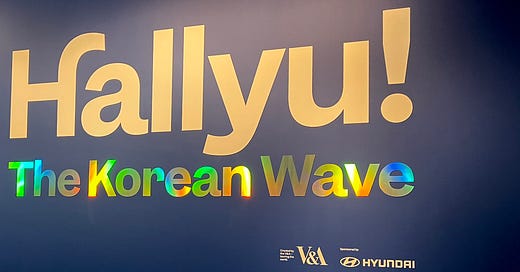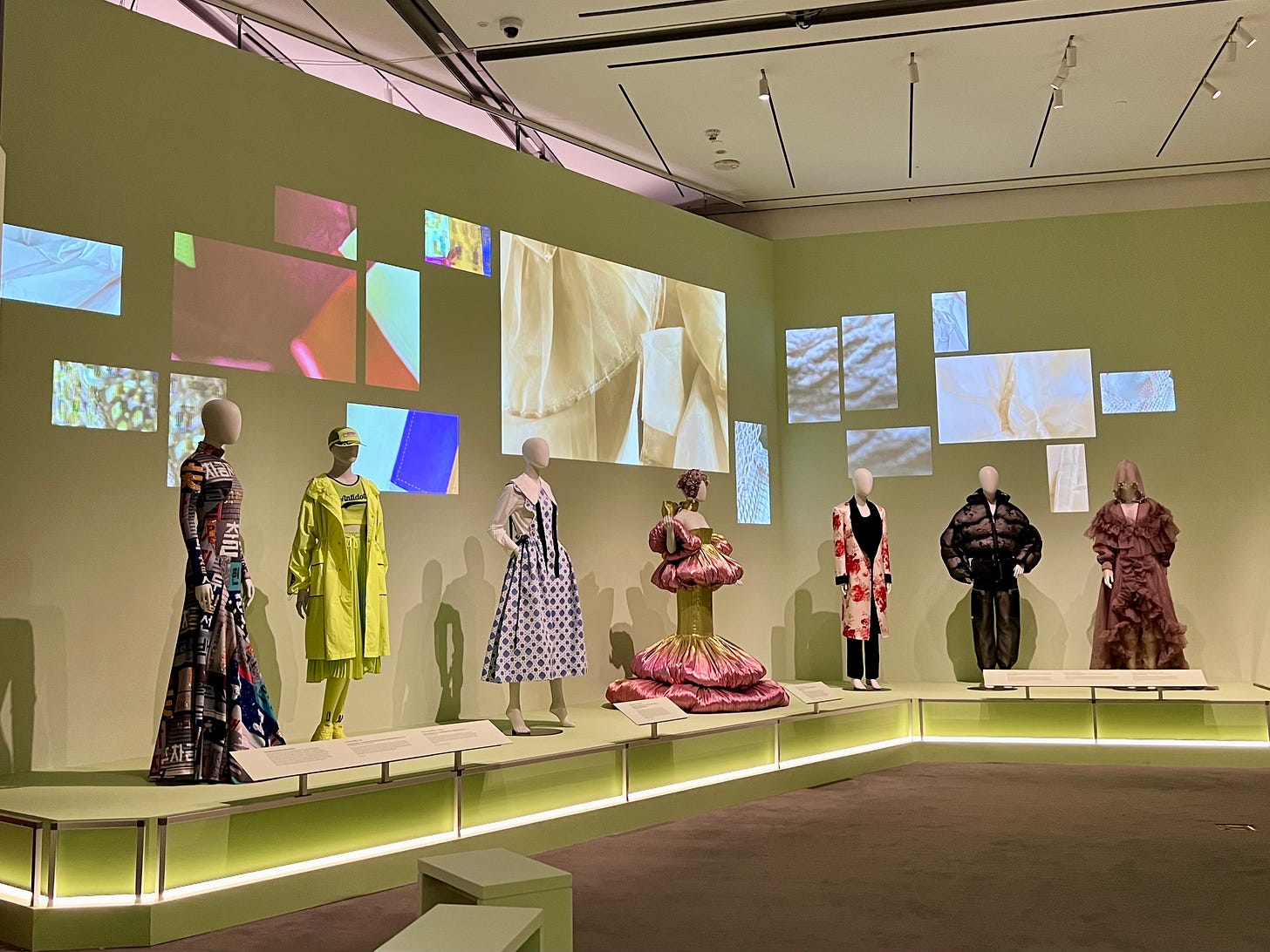On the Apolitical Assault of the MFA’s “Hallyu!” Exhibit
The transnational “Hallyu!” exhibit is not a celebration of South Korean history and culture, but instead reinforces the illusion of postcoloniality and the logic of Western modernity.
by Jesica Bak, Editor-in-Chief
Immediately upon entering, the spectator is introduced with flashy TV screens playing PSY’s “Gangnam Style”; upon further entering, a room full of even flashier, neon-colored outfits worn by generations of K-pop idols on stage, all displayed on mannequins standing on two levels of a futuristic platform. On the wall, a giant screen playing K-pop girl group Aespa’s “Next Level” reminds me that the song was globally popularized by opening for the Wild Rift SEA Championship Grand Finals in 2021. A wall dedicated just to light sticks famously known for being waved around by fans at K-pop concerts. More walls displaying advertisements of Korean actors posing for skincare, posing for Chanel—labeled as a celebration of “genderless beauty.” A poster of the 2009 K-drama Boys Over Flowers that set the stage for positioning Korea within soft masculinity and male aesthetics. Right next to the poster is artist Hwang Eul-Jip’s photo-based depiction of Korea’s cosmetic surgery industry. Hanbok turned into Haute Couture. An intricately constructed replica of the bathroom in Bong Joon-Ho’s Oscar-winning film Parasite.
In March, the Museum of Fine Arts, Boston opened its doors to “Hallyu! The Korean Wave.” Already making headlines for celebrating South Korean cultural exports, the exhibition originates from the Victoria and Albert Museum in London and is soon opening doors in San Francisco. Unsurprisingly, the transnational project is sponsored by the Hyundai Motor Company back on the peninsula, whose press release of the exhibition writes that “Hallyu—the fruit of Korea’s rapid political, social, and economic growth on the back of the enduring US–Korea alliance—stands as a testament to the power of global collaboration and friendship.”
But by now, it should be clear that not only is the exhibit devoid of any actual art, but that perhaps its function is not really to “weave the past and the present” by tracing “the country’s meteoric rise to the world stage… [as] the story of remarkable resilience and innovation”—as the exhibit’s own taglines may want you to believe.
If it is, it has failed miserably; the space in all of its materiality fails to delineate history, fails to offer spaces of political critique against questions of the nation-state, of war and empire, and succeeds only in presenting Korea not as a nation and people with a nuanced history affected by the hierarchies of geopolitics but as an Otherized symbol of soft power, something for the West to gaze upon in bizarre fascination, a series of commodities upon more commodities. Rather than challenging the Western cultural imagination’s habit of relegating South Korea to this handful of cultural commodities, the MFA decided to further spectacularize the nation by showcasing 250 material objects related to K-hyphenated consumption, consumerism, and aesthetics in late stage capitalism.
Paired with a handful of archival photographs and postcards from the Japanese occupation, the exhibit’s pathetic attempt at briefly delineating Korean history is summed up by their didactic text titled “From Rubble to Smartphones,” narrating:
As a country ravaged by war in the late 1950s to a leading cultural powerhouse by the early 2000s, South Korea has experienced a dramatic rise. Its remarkable trajectory from “rags to riches” is marked by governmental control, daring strategies, and IT innovations paired with a ppalli-ppalli (“quick-quick”) ethos, where speed is of the essence… This compressed modern history and hybridity contributed in shaping hallyu.
Such language not only apolitically attempts to rewrite history as if South Korea and South Koreans were able to—with a winning combination of luck, meritocracy, and U.S. aid—transform themselves from a war-torn, rubbled country to the rich, industrialized, globalized powerhouse they are today, but manages to obscure, first and foremost, the question of who exactly ravaged the country with war in the ‘50s.
In fact, not once did I take note anywhere throughout the exhibit, which purportedly claims to weave the past with the present, of a history that accounts for the U.S. casting the very die for the foreboding Japanese colonization of Korea by brokering a 1905 deal that, in exchange for ensuring that Japan would not question “American rights” to the Philippines, the U.S. would not challenge Japan’s right to establishing a protectorate of Korea. Already emulating racist ideologies spread by American missionaries in the East, Theodore Roosevelt won the Nobel Peace Prize for this diplomatic colonial trade-off.
There is no history accounting for the U.S. neglecting Korean exclusion from the liberation process; the U.S. partitioning the two Koreas at the 38th parallel and claiming control of the southern half; even after the physical removal of Japanese empire in 1945, no accounting for the U.S. military government’s institutionalization of education and cultural policies that reinforced the colonial Japanese education system; for the U.S. authorization of the 1980 Kwangju student massacre as well as its proceeding anointment of the orchestrator of the massacre, Chun Doo Hwan, to South Korean presidency; no less its ongoing neocolonial occupation of the South Korean nation-state that remains officially pro-American despite remaining under its militaristic and economic thumb. (There is one line of didactic text from the exhibit aligning a men’s skincare advertisement from 1974 to “the ethos of President Park Chung-hee’s patriarchal military regime and the image of macho men projected by Hollywood films in 1970s Korea.”)
Thus, not only is there no art present in the MFA’s “Hallyu!” exhibit, but there is no possible space for viewers to critique U.S. empire and its role in the state-building process of South Korea—one that was not made attractive with idols and cosmetics, but rather worked in tandem with the political elite of the former colony to further subjugate the Korean people under the patronage of the Cold War powers. The language of the museum is not an accident nor a coincidence, for it is in these kinds of cultural spaces wherein we can locate the narratives of the state that further elude and mystify the internal displacement of a postcolonial South Korean nation today, as well as its contested epistemological landscape.
In other words, it is precisely these kinds of cultural narratives and spaces that function on behalf of the state to position the Republic as a successfully decolonized, postcolonial nation—we must remember that for the MFA, only a country that is postcolonial can be “a country [once] ravaged by war in the late 1950s to a leading cultural powerhouse by the early 2000s.” As such, a crucial part of this successful postcolonial imaginary in South Korea, amongst Korean diaspora, and in the international order writ large, is predicated on the nation’s economic industrialization, political democratization, and transformation into the global and cultural hub it is today. Underlying such language is also the illusion that the logic of Western modernization and globalization brought both economy and democracy, and thus postcoloniality, to the Republic of Korea.
In his timeless 1993 critique of the epistemological landscape of South Korean postcoloniality, Chungmoo Choi writes in “The Discourse of Decolonization and Popular Memory: South Korea,” that this narrative is not only predicated on Koreans’ exclusion from the liberation process, but illustrates what he calls a “colonization of consciousness”—an illusion that the (formerly) colonized live in the same social and cultural sphere as that of the metropolis, and attempt to emulate as such through cultural expression, values, behavior, and the production of knowledge. For Choi, the transitive verbs “to liberate” and “to partition” presuppose a differential positionality between subject (who administers the action) and object (the passive receiver upon which such actions are performed). The “Hallyu!” exhibit, in all its soft power glory, is not a celebration of South Korean culture and nationhood, whatever that may entail, but rather reinforces what Choi warns us of: “that is, while the absence of the real remains uninterrogated, the colonial discourse will continue and colonialism will continue to be reproduced.”






I enjoyed ur writing and research. It has improved much. Keep it up!